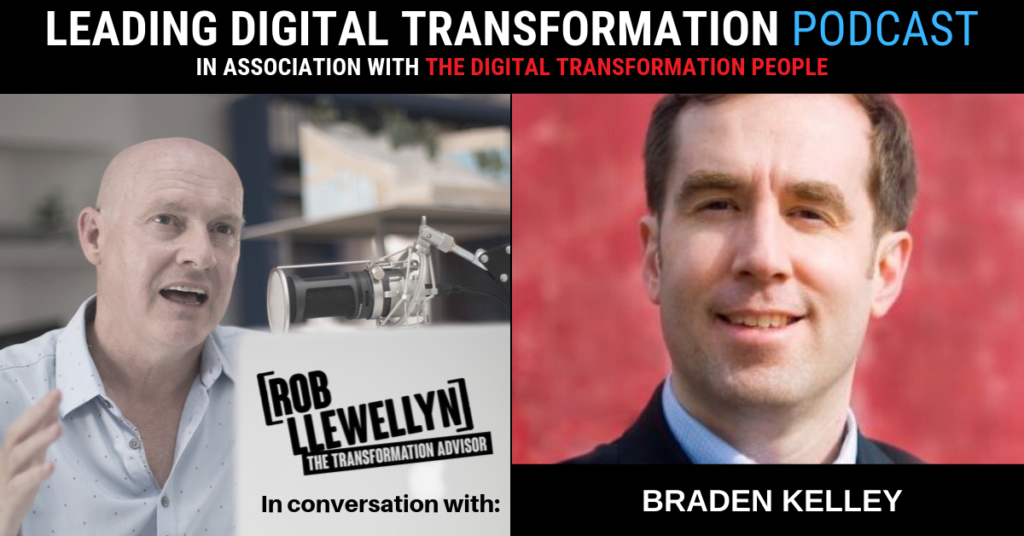‘Leading Digital Transformation’ is a weekly podcast series produced in collaboration between The Digital Transformation People and Rob Llewellyn digital transformation advisor and founder of CXO Transform.
During this series, Rob interviews experienced practitioners, authors and thought leaders whose stories and experiences provide valuable insights for digital transformation success.

In this episode, Rob speaks with Braden Kelley. Design Thinking, Transformation and Innovation Leader at Oracle. A keynote speaker and author of 2 books, ‘Charting Change’ and ‘Stoking Your Innovation Bonfire’, Braden has helped numerous organisations increase their revenue and cut their costs through the creation of innovative strategies, organisational change, digital transformation, and improved organisational performance.
“Those organisations that struggle with innovation are the ones that start at the beginning; when it comes to innovation you need to start at the end…. It’s not about asking people for ideas, it’s about standing ready to actually fund and execute those ideas”
Listen here and read the full transcript below.
Transcript
Rob Llewellyn [00:00:22] Hi and welcome back. I’m joined today by Braden Kelley. Braden is a director of innovation and human-centred problem-solving at Oracle. In his spare time, he’s the author of two popular books: “Stoking Your Innovation Bonfire” and “Charting Change”. He’s a keynote speaker and the driving force behind innovationexcellence.com. And he’s the creator of the Change Planning Tool Kit, which is a suite of tools designed to help people beat the 70 per cent change and transformation failure rate. To learn more about all of this, let’s jump into the interview with Braden. Braden, welcome.
Braden Kelley [00:00:59] Thank you, Rob.
Rob Llewellyn [00:01:00] Hey Braden, I just mentioned in the intro that you’ve written two books. I’m going to delve into your most recent book a little later on, but your first book “Stoking Your Innovation Bonfire” – you wrote that almost 10 years ago, I think in 2010. Now that was a long time before this trend of digital transformation and innovation picked up pace. What inspired you to write a book on innovation so long ago?
Braden Kelley [00:01:28] Well, I actually started writing on the internet about innovation back in 2006 and as I looked around the landscape, as we approached 2010, what I really noticed was that there were a lot of books starting to be out there already on innovation, but there wasn’t a book that really kind of captured how to build an infrastructure for continuous innovation. And that’s the area that I really wanted to tackle is – a lot of people really focussed on how to get good ideas or a lot of books kind of took the approach that innovation was a project. And I didn’t really see it that way and I didn’t think that a lot of the other people that I talked to in industries also saw it that way. And so I thought there was a real opportunity to help people understand what building blocks to put in place consciously to help reinforce the possibility for continuous innovation.
Rob Llewellyn [00:02:19] Now, you’re the co-founder of a website which I’ve been familiar with for a long, long time and I’ve often used as a reference, as I’m sure so many other people listening have, called innovationexcellence.com. Now I want to refer to an article which you wrote there but tell us how innovationexcellence.com came around.
Braden Kelley [00:02:40] Well, it started out as my personal blog back then in 2006 and then over the years, I saw a lot of other great voices out there that had things to say about an innovation that I thought people would find valuable, so I started to invite guest authors onto my blog and it continued to grow and grow up to the point where I came across some individuals that wanted to help grow it further. And I had the opportunity to invite in Rowan Gibson and Dean DeBiase and Julie Anixter to help form Innovation Excellence and give the site a nice clean look and a good opportunity and place for people to contribute great thought-leadership and interesting and different viewpoints all around the topic of innovation. And so that’s kind of how Innovation Excellence was born. And obviously we grew social media assets all around it. We have a LinkedIn group by the same name that has nearly 50,000 members now. And yeah, it’s just always been about the idea of helping to make innovation insights accessible for all.
Rob Llewellyn [00:03:41] Congratulations on creating a tremendous resource there, to you and the rest of the team, amazing. And I was recently looking at one of your articles, which was about the Business Model Canvas and in your opinion why did the Business Model Canvas resonate with people so well?
Braden Kelley [00:03:57] Well, I think that the reason why the Business Model Canvas resonated so well with people was the fact that people are scared by having to create a business plan. It’s a kind of a daunting task. If you look at a lot of the posts on LinkedIn Pro Finder and other places like that, there’s a lot of people looking for help building a business plan. Everybody back then, before the Business Model Canvas came out, always thought that that was the first step that you’re going to create a start-up or try to build something new within an organisation was to create this 100 page business plan and the other aspect I think helped make it so successful is the fact that there are a lot of people are visual learners. And if you look at how the brain is structured, there’s more space allocated in terms of sensory capabilities to vision than to anything else. But there’s another way of looking at it that I recently came up with that I think helps to explain the reason for things like the Business Model Canvas and the Change Planning Tool Kit succeeding and that’s the fact that if you look at words and people using words to communicate, the brain has only opportunity to do serial processing. You have to wait for the next words, but with a picture you can do parallel processing. The brain can do a whole lot of things and pull a whole lot of insight and opportunity out of a single image. And so I think that that’s where tools like the Business Model Canvas are incredibly powerful, because they not only start to access that visual part of the brain, but then they also create an opportunity for collaboration. A business plan moves from being a solo activity to being a group activity and you increase your chances for success as a result. And it also gives you the opportunity to prototype and test and evolve and tweak and create lots of different versions before you have what you feel is the best version and then you can start to put pen to paper.
Rob Llewellyn [00:05:52] You just touched on collaboration. Can this kind of visual collaborative approach be applied to other areas of the business?
Braden Kelley [00:06:00] I really think so. And the whole reason for creating the Change Planning Tool Kit was seeing an approach like the Business Model Canvas or the Lean Canvas and the Empathy Map. Some of these tools that are designed to be printed out poster size and put up on the wall and get people huddled around with sticky notes and Sharpies. That’s an incredibly powerful process. And as I was looking at the organisational change area and working on change programs, again after taking a break, what I found is that the tools that people had for trying to plan and execute organisational change or even a project are incredibly solo or incredibly daunting. I mean, if you think of the PMI approach to managing a project, the first step is to sit down and create a project charter. And if you’re lucky, you might have a Word template to work from. But a project isn’t a solo endeavour: a project is a collaborative effort with a group of people that you not only have to organise but also to motivate and to move forward in a particular direction and to achieve alignment with. And so I didn’t really find the standard Word document Project Charter was going to be a good tool for the kinds of work that I was trying to do so I started to create tools. I started to create tools that would be more visual, more collaborative and started to create them one by one. The most important one was the Change Planning Canvas and that’s an incredibly powerful tool, because what it does is that process of getting people huddled around the poster with the sticky notes is not only do you get more perspectives than just one, but then you have people challenging and poking and pushing and inevitably creating alignment and buy-in as you go through that process. And so that change leadership team up front and the people they’re going to help spread the possibilities of that change across the organisation, it literally helps them get all on the same page, the same physical, nice paper, glossy, colour page and then from there your change effort becomes a lot simpler and there’s a whole host of other tools that help you populate the main components of the Change Planning Canvas. And I created a whole host of new frameworks to help people think differently about change and to help beat that 70 percent failure rate that organisations face when they start to kick off the change project or even a regular project. And as we all know, the pace of technology is accelerating, the pace of change is accelerating. And the S&P 500 is turning over all the time, because of all that change. Companies are constantly being disrupted and you don’t want to be that company that ends up on the losing end of that disruption.
Rob Llewellyn [00:08:42] So did the Business Model Canvas influence the Change Planning Canvas, Braden?
Braden Kelley [00:08:47] It did, because the existence of the Business Model Canvas showed that these kinds of approaches are possible and working with the Business Model Canvas and teaching people how to use it, you really see the power in it and the way that it empowers people to feel that going beyond the idea stage is a possibility for them and they have a way to start thinking about more of the specifics and making their idea actually happen. And they have a way of engaging other people and helping them figure it out, rather than sending a Word document around that they have to actually create first. It takes a huge amount of work to create first and creating a business plan is probably the thing that killed more great ideas than anything else. So helping people get beyond the idea stage to something that’s a little bit more fleshed out and allows them to start to attract support and passionate participants is an incredibly impactful thing for people and I think that’s why it’s spread all around the world.
Rob Llewellyn [00:09:52] Now, I know the Change Planning Tool Kit is based on being very visual and we’re not visual here, we’re just using audio! So here’s a challenge for you: in a couple of minutes just describe what the Change Planning Tool Kit is to those listening that are not familiar with it.
Braden Kelley [00:10:10] Sure. So it’s a collection of over 50 tools that starts with the Change Planning Canvas at the centre but then also has a lot of different components that help people explore the current state and what’s driving the change, to visualise the future and evaluate their change readiness and to plan their desired state. And look at extracting from their group what the potential benefits are and how to work with the people. And then it also introduces several new ways of thinking about change including the 11 change roles and also the 8 change mindsets. And because this kind of a new way of thinking may seem a little bit interesting or challenging to understand for people that haven’t had any exposure to it, I created 10 free downloads for people to download and get an exposure to the kinds of things, the kinds of thinking that goes behind it and that includes things like a visual Project Charter. Also outside the Change Planning Tool Kit, I created an Experiment Canvas to help people in their prototyping and testing phase of innovation. There’s just a whole host of tools to help people plan and execute change and some really useful frameworks to help people think about architecting the organisation for change and how change flows over time and the different stages that you’re gonna go through so you can plan for all of those and look at the potential duration for those so that you can start to actually have a metric for change and your ability to change by measuring over time as you go through your projects how long different types of projects are taking and see whether you’re increasing your organisational agility and your change capacity.
Rob Llewellyn [00:11:53] Braden, you mentioned you’ve got some free downloads. Where can listeners go to get hold of those?
Braden Kelley [00:11:59] Yeah. If you just go to www.BradenKelley.com/CPT for Change Planning Tool Kit, that’s probably the easiest way to get there.
Rob Llewellyn [00:12:07] Okay, great. And I’ll put a link to that in the show notes. Now, we mentioned your first book earlier on, which is “Stoking Your Innovation Bonfire”. You wrote that quite some time ago. Then, I know it’s a lot of work to write a book, then you went ahead and wrote a second book. Did you ever think you’d write a second book? Why did you do that?
Braden Kelley [00:12:26] I actually didn’t think I’d write another book again and that’s partially because that’s a lot of work. And then, because it’s a lot of work, you have to have in my mind a really good idea. I know some people are kind of in the business of writing books and you see a lot of bad business books out there, where you could read 200 pages and only identify one insight. And that’s not the way I like to write books. I like to write books that are packed with insights, that are packed with takeaways, that are packed with things that hopefully make people think and potentially shift their mindset and shift the way that they behave. And so a lot of thinking went into the first book and I didn’t have a great idea for a long time and it was actually as I looked around the landscape and saw the lack of tools to help people that were available for people to plan and execute successful change and as I saw how many change projects failed, it was the creation of the Change Planning Tool Kit that created the impetus for the second book. And one of the cool things I did in the second book was not only that it introduced the Change Planning Tool Kit and helped you understand how to use it and introduced all the frameworks that are behind the worksheets and other tools in the toolkit, but anybody that buys the book gets access to additional supplementary materials, including the Change Planning Canvas. And throughout the book I invited in several guest voices that I thought that had interesting things to say on the topic of change that would take a slightly different perspective than I would, so that people could get a more holistic view and a more modern view on change, because a lot of the great change books are a bit dated by now. The really great ideas are still relevant, but they came out a while ago. And so I invited voices like Seth Kahan and Matthew E. May and Beth Montag Schmaltz and Brett Clay and Babak Forutanpour and Dion Hinchcliffe and all kinds of really cool people that have really interesting things to say on change and attack it from different angles. And so that was another thing that I wanted to do in the new book and I’m always looking to try to figure out what’s the best way to help provide the best experience for people in the book and the most value as they turn the page. And so there’s a lot of great things in the new book that aren’t anywhere else. And so it’s definitely something that I’m really proud of, but because writing a book is a big effort for me personally, it’s not about writing words, it’s about bringing insights and so I had to wait until I had something powerful to say again.
Rob Llewellyn [00:14:55] So your second book we’ve just been talking about is called “Charting Change”. Is the third book in the pipeline yet, Braden?
Braden Kelley [00:15:02] It’s not in the pipeline yet. I mean I have some partial thoughts around something that might be interesting, but I’m not to the point yet where I have something powerful. So until I have something powerful and that’s differentiated, then I won’t write another one.
Rob Llewellyn [00:15:17] That’s clear. You’ve created a tremendous amount of resources through your books and InnovationExcellence.com and other places to help people in innovation and change. What drives you?
Braden Kelley [00:15:28] Well, it’s really about empowering people. So I really love being a tool builder. I really love helping people figure out ways to succeed in their own careers and their own work lives. And so, what really drives me is trying to make information accessible for the greater good, to make insights accessible for the greater good. And so, I really love trying to figure out where people are struggling to understand how to approach something or to succeed in a particular area, where things are really hard and try to find a way to simplify complexity and to find a way to allow people to achieve resonance with the people that they’re working with, so that they can achieve powerful outcomes.
Rob Llewellyn [00:16:09] I want to go back to InnovationExcellence.com, Braden. You started that back when? What was the year?
Braden Kelley [00:16:14] Well, the seeds for it started back in 2006 and then became Innovation Excellence I believe it was back in 2012, if I remember correctly.
Rob Llewellyn [00:16:23] How have you seen it mature over the last 10 years, particularly with innovation getting to the forefront of so many organisations now, because what’s happening in our economy, with digital, etc.? How have you seen it evolve over the last decade?
Braden Kelley [00:16:38] Sure. So I think some of the ways that it’s evolved over time is that in the earlier days, there was more of a focus on helping people understand what innovation is and really helping to frame the conversation around the topic area. But I think as people still don’t agree on what innovation is, unfortunately, a lot of people confuse innovation with invention and they’re not the same thing. Invention is about creating things that are useful, innovation is about creating things that are valuable and a lot of inventions never become innovations. So in those early days, we were trying to help craft the discussion, help shape the discussion. And now there are different elements as people have created innovation practices within organisations which weren’t there in the earlier days. People are more interested in other topic areas, areas like design thinking, areas like digital transformation, areas like organisational change and also areas like intrapreneurship, which is different than entrepreneurship. Intrapreneurship is like entrepreneurship, but the company is taking more of the financial risk. So it’s a really great opportunity for people that do want to be entrepreneurial but are afraid of the risk to come up with ideas and help make them real within an organisation using the resources of the organisation they work for. And so that’s become a greater area of interest for people and also the interplay between big companies and start-ups and how to leverage people outside the organisation to make innovation happen. And so it’s become a bigger and broader topic area as people start to at least somewhat agree on the core elements of what innovation is.
Rob Llewellyn [00:18:25] Yeah, you mentioned that a lot of organisations are now setting up their own innovation practices, call them what they will. What challenges do you see organisations are typically facing in terms of approaching innovation in an effective way? You’ve mentioned there are different perceptions of innovation, of transformation, etc.. But in terms of innovation, what are the big challenges [for] organisations that want to do this? They want to innovate, but they’re not quite hitting the nail on the head.
Braden Kelley [00:18:55] Sure. So the organisations that struggle to hit the nail on the head are the organisations that start at the beginning. I know that may sound weird, but when it comes to innovation, you want to start at the end. When it comes to corporate innovation, when it comes to being successful, when it comes to creating something that’s sustainable, and what I mean by “you need to start at the end” is it’s not about asking people for ideas, it’s about standing ready to actually fund and execute those ideas. And where a lot of companies go wrong is they think it’s about the ideas and they think that “oh, we’ll just ask people for their ideas and that’ll make them feel good and then we’re doing innovation”. And that’s not the case. The best way to kill innovation in the longer term is to ask people for their ideas and then not do anything with them, because that’s going to destroy the trust, it’s going to destroy the engagement. And so, the best organisations try to figure out what they’re going to do with all the ideas and the kinds of ideas that they want before they ask for anybody to contribute anything. And as I wrote in the first book “Stoking Your Innovation Bonfire”, then as part of that conversation: “You’re building your innovation vision”, “you’re building your innovation strategy,” “you’re figuring out what your goals for innovation are” and you’re figuring out all these kinds of really important answers to questions around what innovation means to you as an organisation and who you want to be involved, how you want them to be involved. And you’re figuring out the process and the practice before you start looking for the content.
Rob Llewellyn [00:20:27] Braden, we’re getting close to our time, but tell us, what are you focussed on now? And bearing in mind that you don’t have another third book in the pipeline at the moment, what are you focussed on right now?
Braden Kelley [00:20:36] Well, I started a new job with Oracle and what I’m doing there is really diving deeply into how do we go beyond design thinking to help customers. And so we’re looking at how do we meld the best of design thinking and organisational change and digital transformation and innovation to help companies innovate, grow, transform and leverage their technology investments to do amazing things for their customers. And so that’s what I’m focussed on now and as I do that, I’m looking for new opportunities to dive deep into the human elements of innovation and so stay tuned. I may create some new tools and things, but it’s just – I think that there’s still a tremendous amount of opportunity out there to help organisations find those resonance points with their customers and their employees to drive engagement and to increase their chances of surviving over the long term and thriving. And so that’s what I’m focussed on.
Rob Llewellyn [00:21:37] Braden, it’s been a pleasure speaking with you today. We could talk for hours on this, I certainly know you could! We’ve got the two books and we put links to those in the show notes. Where else – of course, there’s InnovationExcellence.com – where else can people go to learn more about what you’ve got to share?
Braden Kelley [00:21:53] Sure. So people can find me on Twitter at www.twitter.com/innovate. They can also find me on Instagram as Mr. Innovation, where I’ve started to publish a whole host of quote posters to help people spread the love for innovation. And then my site is www.BradenKelley.com. And on there you’ll find all the information about the books and speaking engagements and articles and white papers and videos and all kinds other fun stuff.
Rob Llewellyn [00:22:21] Braden, thank you so much.
Braden Kelley [00:22:23] Great, thanks Rob. Thanks for having me. I really enjoyed the conversation.
Announcer: [00:22:28] We hope you enjoyed this episode of “Leading Digital Transformation” with Rob Llewellyn and The Digital Transformation People. Visit www.thedigitaltransformationpeople.com to secure the knowledge, talent and services you need for digital transformation success. To continue your journey as a certified transformation professional, visit www.RobLlewellyn.com. Be sure to subscribe to the podcast and follow us on Twitter, @TheDigitalTP and @RobertLlewellyn.
Article by channel:
Everything you need to know about Digital Transformation
The best articles, news and events direct to your inbox
Read more articles tagged: Featured, Innovation






